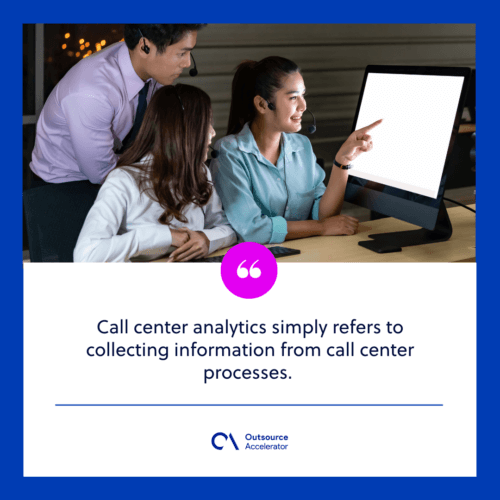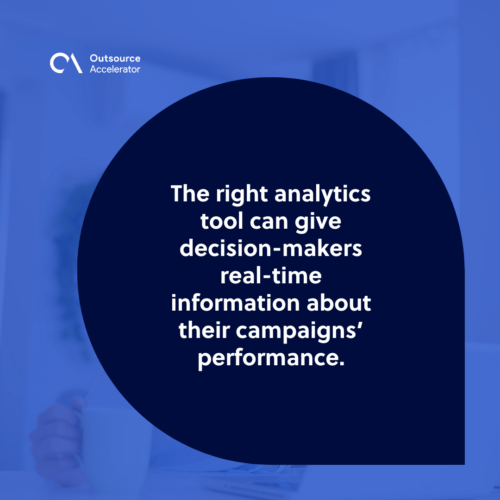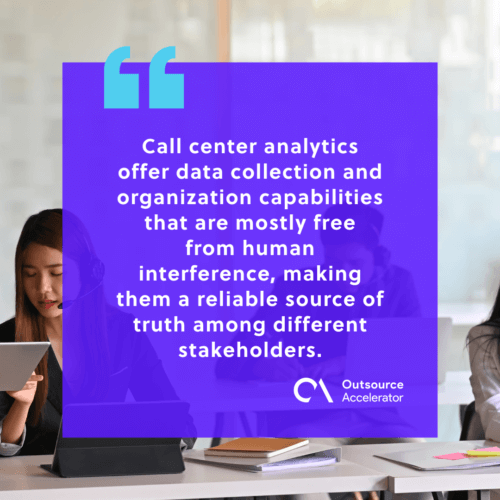Leveraging data: 5 benefits of using call center analytics

Wherever data is transferred, data is recorded. This is why call center analytics has become essential to the business process outsourcing (BPO) industry.
Examining past calls reveals much information about your clients and call center agents. In performing analytics, administrators and team leads gain insight into existing practices. They can find opportunities for improvement and drive growth for the organization.
While the extra investment and organizational changes deter some companies from adopting call center analytics, it helps to understand how the returns outweigh the costs.
What is call center analytics?
Call center analytics simply refers to collecting information from call center processes. While it initially pertained to digging customer information from day-to-day operations, the term has grown to include the evaluation of performance metrics.
Customer satisfaction (CSAT), retention time, and service-level agreement (SLA) performance are among the areas examined.
A firm like Catalyst BPX relies on these metrics to deliver consistent service.
Beyond simply understanding agent and customer performance, analytics tools also provide valuable insight into market behavior. By understanding emerging trends and changing customer preferences, companies can develop new products and services and test them on potential customers.
Keeping up with customer preferences is crucial in retaining old customers or gaining new ones. In fact, Salesforce’s 2022 report reveals that 71% of consumers have shifted brands at least once in the previous year.
Information used in call center analytics can come from every corner of your operations. Sources include but are not limited to:
- Voice and video recordings
- Call and chat transcripts
- System event logs
- Customer survey forms
- Interactive voice response (IVR) recordings
- Customer relationship management (CRM) software logs
The sources listed above show that information can be directly lifted from the very tools companies use for their daily operations. It’s a matter of organizing and presenting these pieces of data in forms that are relevant to the different stakeholders in a company.

5 ways call center analytics improve daily operations
Including analytics as a part of operations has become commonplace, even among call center agencies. However, it might be surprising to know about two-thirds of chief-level executives still disregard data and make intuition-driven decisions.
By leveraging the information you gather from your call center analytics strategy, you stand to benefit in these five surprising ways:
1. Keeps your entire team aligned
Whether it’s technology or marketing, keeping up with rapidly-changing customer demands is essential for relevance and survival in this day and age. Usually, leaders are tasked with designing and implementing campaigns to achieve specific targets.
The right analytics tool can give decision-makers real-time information about their campaigns’ performance. More importantly, it can quickly identify gaps in the strategy before they even make a negative impact.
This alignment even extends beyond time-bound campaigns. It could spill over to long-term strategies such as building company culture. By identifying relevant metrics that direct agents, you can better identify the qualities you need as you source your next talent.

2. Improves operational agility
Call center agencies often stand between companies and their clients. Their mission is to respond to customer concerns quickly, de-escalate any potential issues, and improve a customer’s overall perception of a brand.
An outdated misconception is that larger call volumes mean more business. Unfortunately, this focus on quantity sacrifices quality.
You get overworked agents who no longer deliver quality responses. This scenario is exactly why data analytics are important.
In doing so, you distribute call volumes effectively. This leads to shorter wait times, faster agent responses, and an overall improvement in customer satisfaction.
3. Increase sales conversion
Your CRM and call center software automatically keep a record of your transactions. However, a good way of leveraging these data is to identify opportunities to improve your existing conversion rates.
Databases containing customer profiles, demographic information, and sales conversion history can provide you with a hint about what is becoming trendy right now. By identifying these items, you can redirect your sales agents to promote these products or help announce an upcoming promo.
More importantly, historical data can help business owners assess the effectiveness of their outsourced process and ensure that their call center fits their business.
4. Develop speech and text analytics
With the rise of artificial intelligence, automation has found a new role among call center agencies. Your analytics data can help build unique speech and text patterns that can automate call rerouting and scheduling.
Nowadays, AI can recognize keywords, inflections, and tone to sort out customer and call information. Taking it a step further, it can be used to measure your product or agent’s performance.
Additionally, call center analytics built on speech and text recognition are becoming increasingly popular as a social listening approach. This has become a marketing intelligence tool used by 61% of businesses in recent years.
5. Make data-driven decisions
Ultimately, all other benefits can be traced down to the use of objective and data-driven decisions.
Call center analytics offer data collection and organization capabilities that are mostly free from human interference, making them a reliable source of truth among different stakeholders.
Historical data can be used to make projections for future plans. Similarly, real-time information offers insights into conversion rates, call times, and other relevant metrics.
Set up your call center analytics today
Although there might be changes involved in adapting call center analytics, the benefits greatly outweigh the costs and incentivize this approach for call center agencies of all sizes.
To ensure that your team keeps up with the minute changes in the market, learning how to wield data will definitely come in handy.
By examining the benefits listed above, decision-makers can better justify a much-needed change in their existing operational paradigms. With call center analytics, leaders gain more visibility over the business while agents obtain a clearer direction.








 Independent
Independent




